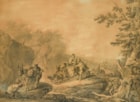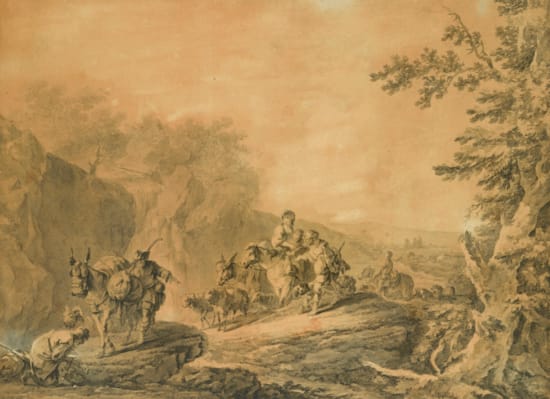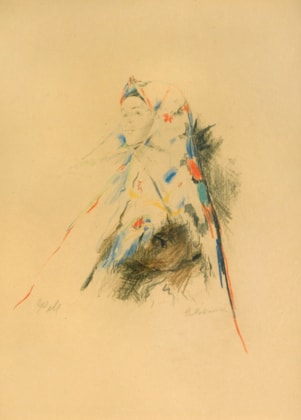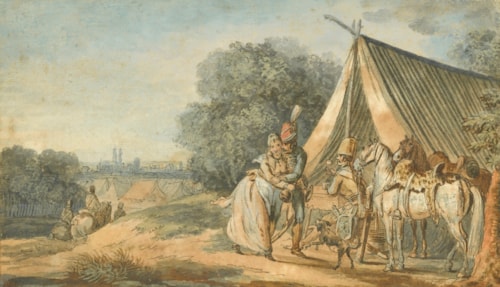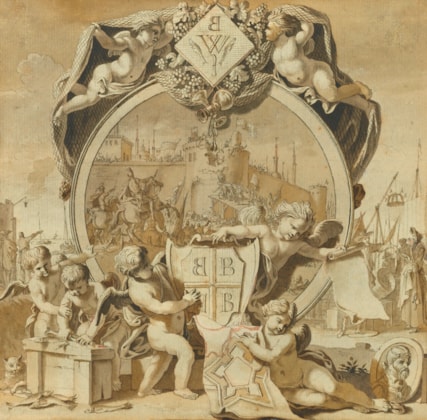rancesco Giuseppe Casanova
(London 1727 - Brühl 1803)
A Shepherd’s Family Travelling with their Flock
signed ‘F. Casanova.’ (bottom right)
lead pencil and sepia wash
56.5 x 41.5 cm (22¼ x 16⅞ in)
Francesco Giuseppe Casanova’s drawing shows a group of travellers making their way through a rocky landscape. The path, up which the travellers make their way, is framed by a wall of rock and a withered tree, so that the viewer’s eye is led back into the extensive background. The group of people file through the scene, surrounded by their animals. The sheep suggest that they are shepherds, though their group of animals also includes a dog, horses and two heavily-laden mules. The heavy and full parcels they are carrying with them suggest that they are nomadic, perhaps moving to higher fertile grounds to graze their livestock over the summer months. On the left-hand side a figure kneels to pick something off the ground whilst to his right, another guides one of the mules. He points at something, perhaps warning the young family who follow of some uneven ground. At the back of the group another shepherd waits patiently for the flock, who slowly amble along behind the others.
In A Shepherd’s Family Travelling with their Flock, Casanova has placed his figures in the type of rugged, rocky landscape that recurs throughout his work. The ground is uphill, barren and uneven. There is a wall of rock on the left-hand side, and the few trees that are in the scene are relatively bare with snapped branches. Casanova often depicted this sort of rough landscape, for example in The Waterfall. This drawing is characterised by the torrent of water spewing out from the craggy rock. It is a depiction of a nature which is wild and untamed. Despite being focused around the water it is in a similar vein to that of A Shepherd’s Family Travelling with their Flock. Both drawings also demonstrate Casanova’s tonal variation. In A Shepherd’s Family Travelling with their Flock the area where the family are is illuminated, whereas the surrounding ground is cast in shadow. Similarly, in The Waterfall a bright light shines on the water and the top of the rock, and other parts of the drawing remain untouched by the intense sunshine.
Although born in London, where his actor parents had been touring, Casanova was raised in Venice and the art of that city was an important influence on his career. According to the Mémoires of his brother, Giovanni Giacomo (1728/30-1795), Casanova studied drawing with Gianantonio Guardi (1699-1760) for ten years in Venice. In 1757 Casanova began working in Paris and quickly became a much sought after court painter of battle, hunting and equestrian scenes and his work was critically well received when exhibited at the Salon. In addition to numerous military paintings he also painted many landscapes, which are often dotted with rural figures such as farmers or shepherds, as seen in both A Shepherd’s Family Travelling with their Flock and other works such as Resting Herdsmen with Donkey and Herd (Albertina Museum, Vienna). By about 1772, he had begun to design tapestry cartoons for the royal factories in Beauvais and Aubusson whilst continuing to exhibit publically until 1783 when he returned to Venice. Other significant patrons from the latter stages of his career included Prince Nicolas Esterházy of Hungary, Ferdinand IV, the Bourbon King of Naples and Catherine the Great of Russia.
Veil-Picardy Collection, Paris
Francesco Giuseppe Casanova’s drawing shows a group of travellers making their way through a rocky landscape. The path, up which the travellers make their way, is framed by a wall of rock and a withered tree, so that the viewer’s eye is led back into the extensive background. The group of people file through the scene, surrounded by their animals. The sheep suggest that they are shepherds, though their group of animals also includes a dog, horses and two heavily-laden mules. The heavy and full parcels they are carrying with them suggest that they are nomadic, perhaps moving to higher fertile grounds to graze their livestock over the summer months. On the left-hand side a figure kneels to pick something off the ground whilst to his right, another guides one of the mules. He points at something, perhaps warning the young family who follow of some uneven ground. At the back of the group another shepherd waits patiently for the flock, who slowly amble along behind the others.
In A Shepherd’s Family Travelling with their Flock, Casanova has placed his figures in the type of rugged, rocky landscape that recurs throughout his work. The ground is uphill, barren and uneven. There is a wall of rock on the left-hand side, and the few trees that are in the scene are relatively bare with snapped branches. Casanova often depicted this sort of rough landscape, for example in The Waterfall. This drawing is characterised by the torrent of water spewing out from the craggy rock. It is a depiction of a nature which is wild and untamed. Despite being focused around the water it is in a similar vein to that of A Shepherd’s Family Travelling with their Flock. Both drawings also demonstrate Casanova’s tonal variation. In A Shepherd’s Family Travelling with their Flock the area where the family are is illuminated, whereas the surrounding ground is cast in shadow. Similarly, in The Waterfall a bright light shines on the water and the top of the rock, and other parts of the drawing remain untouched by the intense sunshine.
Although born in London, where his actor parents had been touring, Casanova was raised in Venice and the art of that city was an important influence on his career. According to the Mémoires of his brother, Giovanni Giacomo (1728/30-1795), Casanova studied drawing with Gianantonio Guardi (1699-1760) for ten years in Venice. In 1757 Casanova began working in Paris and quickly became a much sought after court painter of battle, hunting and equestrian scenes and his work was critically well received when exhibited at the Salon. In addition to numerous military paintings he also painted many landscapes, which are often dotted with rural figures such as farmers or shepherds, as seen in both A Shepherd’s Family Travelling with their Flock and other works such as Resting Herdsmen with Donkey and Herd (Albertina Museum, Vienna). By about 1772, he had begun to design tapestry cartoons for the royal factories in Beauvais and Aubusson whilst continuing to exhibit publically until 1783 when he returned to Venice. Other significant patrons from the latter stages of his career included Prince Nicolas Esterházy of Hungary, Ferdinand IV, the Bourbon King of Naples and Catherine the Great of Russia.
Veil-Picardy Collection, Paris




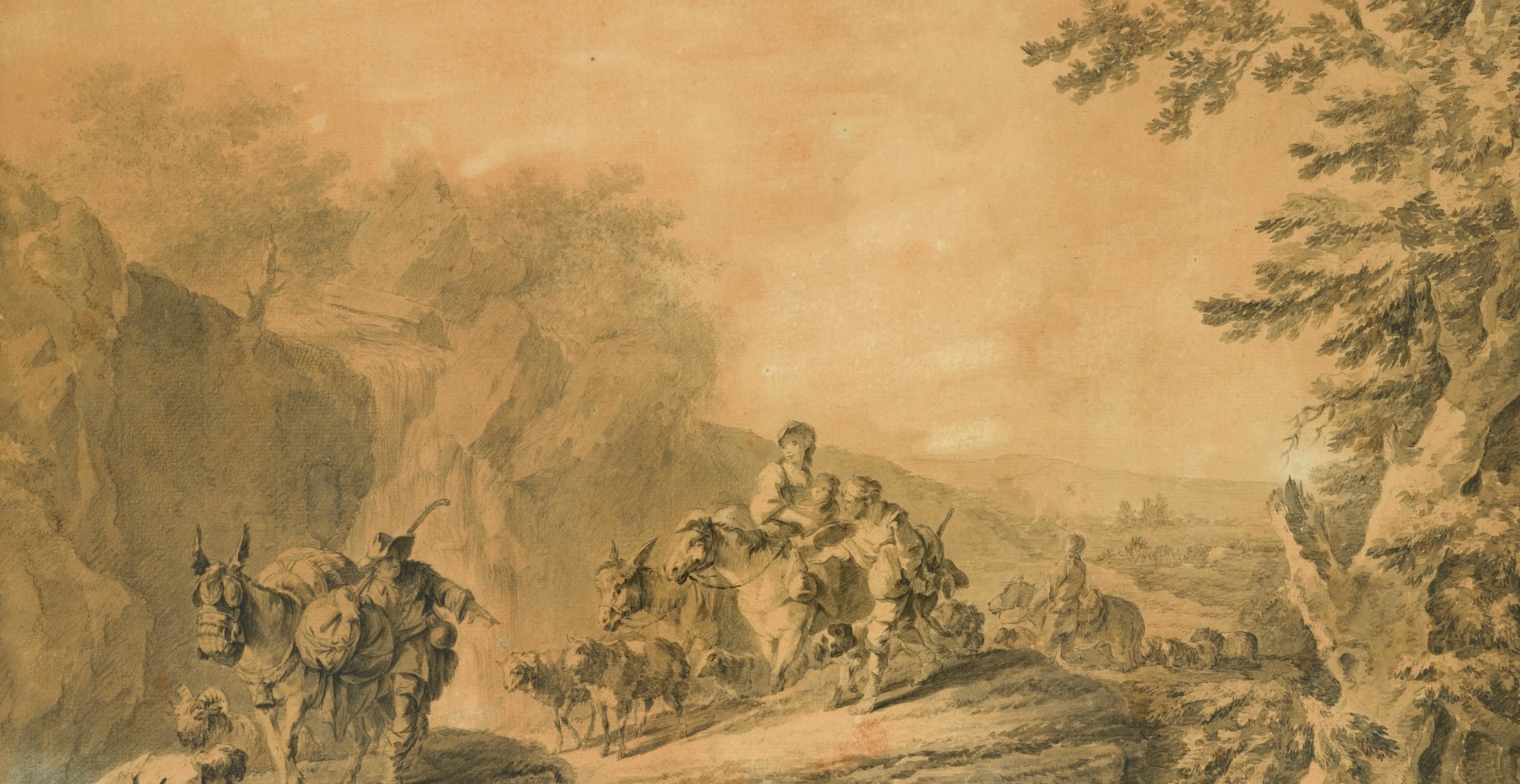
 contact
contact contact
contact +44 20 7313 8040
+44 20 7313 8040